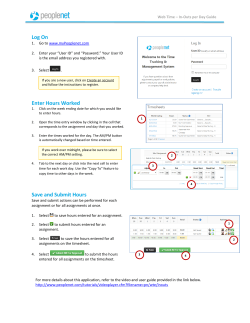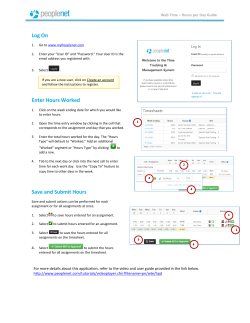
Hazard Community and Technical College
Hazard Community and Technical College Course Syllabus HIT 207 45Z1: Clinical Classifications III (10587-45Z1) Spring/2015/Online Instructor Contact Information Instructor Name/Title: Shalena Jarvis, RHIT, CCS / Instructor Office Hours: Bb IM Online Office Hrs Mondays: 12-2 pm EST Wednesdays: 12 – 2 pm EST Phone Number: 606.487.3332 In Person Office Hrs Tuesdays: 9 am – 12 pm EST Thursdays: 9 am – 12 pm EST Office Location: First Federal Center Room 213 G Hazard Campus Email Address: shalena.jarvis@kctcs.edu Course Information Course Description Introduces the advanced application of clinical classification systems in the reimbursement for health care services and “specialty” systems such as RBRVS, OASIS, RUGs, Cancer Registry, etc. Reviews fraud, abuse, and regulatory agency requirements relating to coding and billing. Prerequisites Admission to the Health Information Technology Program or Medical Record Coding Specialist Certificate or Release of Information Data Specialist or by special permission of the Program Coordinator. Pre Or Co-requisite: HIT 109 and HIT 202. Minimum grade of “C”. Start Date: January 12, 2015 Midterm: March 9, 2015 End Date: May 1, 2015 Textbook Information and Supplies A Guided Approach to Intermediate and Advanced Coding; Lame; Pearson; ISBN 9780132920711 ICD-10-PCS; Optum; Cengage; ISBN 9781622540181 ICD-10-CM; Optum; Cengage; ISBN 9781622540679 CPT Professional Edition; Optum; Cengage; ISBN 9781622020263 Course Competencies/Student Learning Outcomes Upon successful completion of this course, the student will be able to: 1 Hazard Community and Technical College Course Syllabus 1. Discuss advanced coding and reimbursement issues in relationship to health care reimbursement. (Chapter 1; Reimbursement discussion) 2. Discuss fraud and abuse issues as they relate to medical record coding. (Fraud and Abuse discussion) 3. Apply coding principles to optimize reimbursement. (Chapters 3-8) 4. Accurately code medical records for reimbursement of health care services. (Chapters 3-8) American Health Information Management Association Domains, Tasks, and Subtask for Registered Health Information Technician This course either meets and/or contributes to the following domains, subdomains, and tasks: Domain 1A Health Data Structure, Content, and Standards Domain: 1C Clinical Classification Systems Assessment measure: All competencies will be measured through chapter assessments, discussion board activities, coding labs, chapter activities, case studies, and competency based questions on exams. Plagiarism Class Policy You must submit your own work for a grade. You must not give or receive unauthorized aid on papers, reports, exams, quizzes, or other assignments. Submitting graded assignments that are not your original work or on which you have given or received unauthorized aid is cheating. If you have questions on what constitutes appropriate aid on your assignments, please consult with me. Words and ideas taken from any source must be carefully documented in your papers. The deliberate and unauthorized use of words and ideas from an unacknowledged source without appropriate documentation is plagiarism. If you have questions about how to document your assignments appropriately, please consult with me. Proven instances of cheating or plagiarism make you liable to a variety of penalties, including failure of the assignment, failure of the course, and/or expulsion. Course Structure, Evaluation, and Grading Methods Grades will be obtained through coding labs, discussion assignments, chapter assessments, a report, and a final exam. All due dates and assignments will be posted on the course site. Grading rubric for case study is located in Blackboard attached to assignment. Syllabus Exam Discussion Case Studies Coding Lab Exercises Chapter Quizzes Final Total pts 1 3 4 6 4 1 50 pts 50 pts 50 pts 25 pts 50 pts 100 pts Grading Policy/Scale 2 50 150 200 150 200 100 850 Hazard Community and Technical College Course Syllabus To calculate your grade, add together all the points you have received and divide that number by the total number of possible points for the class (850); then multiple that number by 100 to get the percentage for the letter grade. For example, let’s say you have received 625 points. Example: 625 / 850 = 0.7353 x 100 = 73.53 (using the letter grading scale below, this is a C) The grading scale is as follows: 100 – 90 = A 89.9 – 80 = B 79.9 – 70 = C 69.9 – 60 = D 59.9 or less = E HIT 207 Course Schedule - specific learning information including student learning activities, resources, reading assignments, lecture presentations, and discussions can be found in the Blackboard course shell under Learning Content. Dates Subject Chapter(s) CAHIIM 1/12-1/16 Read syllabus; Complete week 1 assignments (located in Blackboard under Learning Content) Syllabus exam (due 1/20) Pre-coding test (due 1/20) 1/20-1/23 Read and complete Chapter 1 assignments; 1 Chapter 1: The Role of the Medical Coder in Healthcare; Start Fraud and Abuse Research Discussion Board assignment (located in Blackboard under Discussion Board); Start Reimbursement Research Discussion Board assignment; 1/26-1/30 Read and complete Chapter 2 assignments; 2 Chapter 2: Documentation and Coding Review; Start Documentation Research Discussion Board assignment Start RBRVs, OASIS, and RUGs Case Study 2/2-2/6 Quiz (Chapters 1 and 2) due 2/5 1, 2 I.A.1 Fraud and Abuse discussion due 2/6 I.A.2 Reimbursement discussion due 2/6 I.C.5 Documentation discussion due 2/6 RBRVs, OASIS, and RUGs Case Study due 2/6 2/9-2/13 Read and complete Chapter 3 assignments; 3 Chapter 3: Intermediate Physician Office Coding - Let’s Practice Coding Cases and Chapter Review Questions 3 Hazard Community and Technical College Course Syllabus Dates 2/17-2/20 2/23-2/27 3/1-3/6 3/9-3/13 3/16-3/20 3/23-3/27 3/30-4/2 4/6 4/7-4/10 4/14-4/17 4/21-4/24 Subject Continue studying chapter 3 and completing assignments; Coding Lab Exercise (chapter 3) due 2/19 Chapter 3 Quiz due 2/20 Read and complete chapter 4 assignments; Chapter 4: Intermediate Outpatient Hospital CodingLet’s Practice Coding Cases and Chapter Review Questions Continue studying chapter 4 and completing assignments; Coding Lab Exercise (chapter 4) due 3/5 Chapter 4 Quiz due 3/6 ----------------Spring Break---------------------------Read and complete chapter 5 assignments; Chapter 5: Intermediate Inpatient Hospital Coding- Let’s Practice Coding Cases and Chapter Review Questions Continue studying chapter 5 and completing assignments; Coding Lab Exercise (chapter 5) due 3/26 Chapter 5 Quiz due 3/27 Case Studies – 1) Coding Quality in ICD Coding; 2) Documentation Support for Principal Diagnosis; 3) Improving Coding Quality Case Studies Due 1) Coding Quality in ICD Coding Case Study due 4/6 2) Documentation Support for Principal Diagnosis Case Study due 4/6 3) Improving Coding Quality Case Study due 4/6 Read and complete chapter 6 assignments; Chapter 6: Advanced Physician Office Coding - Let’s Practice Coding Cases and Chapter Review Questions Coding Lab Exercise (chapter 6) due 4/13 Read and complete chapter 7 assignments; Chapter 7: Advanced Outpatient Hospital Coding - Let’s Practice Coding Cases and Chapter Review Questions Coding Lab Exercise (chapter 7) due 4/20 Read and complete chapter 8 assignments; 4 Chapter(s) CAHIIM I.C.2 I.C.4 I.C.5 4 I.C.2 I.C.4 I.C.5 5 I.C.2 I.C.3 I.C.4 I.C.5 I.C.4 I.C.5 I.C.7 6 I.C.2 I.C.4 I.C.5 7 I.C.2 I.C.4 I.C.5 8 I.C.2 Hazard Community and Technical College Course Syllabus Dates 4/28-5/1 5/5 Subject Chapter 8: Advanced Inpatient Hospital Coding - Let’s Practice Coding Cases and Chapter Review Questions Coding Lab Exercise (chapter 8) due 4/27 Prepare for final exam (comprehensive covering chapters 1-5). Coding Post Test due 5/1 Final Due Chapter(s) CAHIIM I.C.3 I.C.4 I.C.5 I.C.1 I.C.4 *Discussions, quizzes, case studies, coding labs, and final will be available at the beginning of the semester. Please note that ALL assignments have a due date. Access to the coding labs, quizzes, and final will close at 11:59 p.m. on the due date. All times are EST. Discussion Activities: In order to receive full credit for the discussion assignment, you must compose a complete response to the discussion question, as well as construct a thorough reply to a classmate’s post. Fraud and Abuse Research Discussion requires you read two AHIMA articles over ethics of coding and fraud and abuse. After reading the articles you must do more research over coding fraud and abuse and discuss your findings (such as specific cases or interesting facts). Reimbursement Issues Research Discussion requires you read three articles related to reimbursement. After reading the articles you must research and post your findings over reimbursement issues and explain how you would handle the issue if you were a CEO. Documentation Research Discussion requires you research and identify two ICD-9-CM codes that will require more specific documentation in ICD-10-CM. Your post must include the code(s) used in ICD-9-CM and the ICD-10-CM code(s) and describe the changes between the codes as it relates to documentation. Then develop and explain the training plan you would use to train physicians on documentation and its importance. Case Study Activity: Grading rubric for the case study can be found in Blackboard in the Grade Center. The rubric is attached to the assignment. In addition, you can find an example of the case study format to be used in Blackboard under Learning Content for chapter 2. RBRVs, OASIS, and RUGs Case Study requires you research each code type and explain what each represents and how they are used. Coding Quality in ICD Coding Case Study provides you with a report showing discharge diagnoses codes. You must review and analyze the report to identify coding quality issues when compared with the official coding guidelines. 5 Hazard Community and Technical College Course Syllabus Documentation Support for Principal Diagnosis provides you with a scenario where you are a coding supervisor and must assist a HIT student with coding questions. You are presented with a list of common principal diagnosis codes. You must justify for the HIT student either why the codes ‘do’ or ‘do not’ support the documentation. Improving Coding Quality Case Study provides a scenario where you are the coding supervisor performing coding audits. During those audits you have identified patterns in the coding errors. The top three problem areas where codes are consistently miscoding are: skin coronary artery bypass grafts (CABGs), respiratory failure, and heart catheterizations. You must assess what you can do to improve the coding quality issues. Evaluate different options to improve the coding quality issues including what role the encoder can play in coding quality. Class Policies/Procedures Inclement Weather Class Policy/Procedure During periods of inclement weather, all courses scheduled BEFORE 9:30 a.m., will be cancelled. Learners will be asked to report at 9:30 for their 9:30 courses. Since this course is taught via the internet, this section does not apply. Regardless of weather, this class will meet and assignments will be due on their appropriate due date. General Class Make-up/Late Assignment Class Policy/Procedure (including weather related make-up plan) Learners will not be permitted to “make-up” exams or assignments. Learners will have ample time to complete and submit exams and assignments on or before their due dates. Exam and assignment due dates will be posted on the course calendar and will be announced through the course announcements. It is the responsibility of the learner to ensure they are checking the course site (including class message and announcement sections) and due dates so exams/assignments are not missed. Once an assignment dropbox, exam, or discussion board is closed, it WILL NOT be reopened. It is vital to keep up with due dates of assignments. I do understand extraneous circumstances can arise throughout a semester. However, I have arranged the course so learners will be able to successfully meet deadlines and/or make arrangements as necessary to meet those deadlines. Not having access to your computer is not an excuse for missing a due date. Online courses can be accessed from any computer that has the internet. Therefore, plan accordingly for completion of assignments. Since this is an online course, the majority of interaction will occur through emails, class messages, discussions, and instant messaging. Please remember sometimes the “personal” touch is lost when interacting online. Sometimes conversational tone is misunderstood and the reader interrupts the message differently than the intent of the sender. If in doubt, please contact the sender via phone or in person. 6 Hazard Community and Technical College Course Syllabus Please be professional when sending messages. Use business standard words, punctuation, etc. Please refrain from using text messaging jargon. For example: do not use U R for you are. Please key everything out. Remember practicing accuracy is important in this class. If you email me a question, please expect a 24-48 hour response time through the week. If you message or email me over a weekend, response time may be longer. Attendance Class Policy/Procedure This class is taught via the internet. Participation is required on all assignments/discussions. Learner work is tracked and viewable by the instructor. I am able to monitor your progress for each section. I can also monitor when you logged into the class, the time you spent on each section, and when you logged out. In order to be successful in this class, you will need to check the class for updates at least three times a week. This includes checking the announcement section, as well as the class message section. Class announcements will be posted weekly, and class messages may be sent periodically. You will need to read and study your chapter work on a daily basis and submit your work by the indicated due date. All due dates will be posted on the course calendar. Withdrawal Class Policy/Procedure A student may officially withdraw from any class up to and including the date of mid-term with a W grade assigned to the student’s record. Once permission has been granted to withdraw, it is the learner’s responsibility to ensure all paperwork is completed and submitted to the appropriate registrar. Otherwise, a grade of “E” will be received. No “I” (incomplete) grades will be given. Since this course is part of a selective admission program and is a pre-requisite to future courses, if you choose to withdraw from this course, you will not be able to continue in the program. Accommodations Procedure Learners needing specific accommodations should contact the local disabilities service representative to complete an Accommodations Plan which will ensure that the Learner receive full benefits and that the instructor is aware and can make the proper adjustments in his/her courses. The HCTC Disabilities Services Representative is Melissa Johnson, phone (606)-487-3405, email MelissaD.johnson@kctcs.edu. Appeals Process Always begin the informal process by talking to your instructor. If issues cannot be resolved, then talk with the Division Chair (see below for contact information). For information about academic rights, academic offenses and the Learner’s formal right to appeal, Learners should review the KCTCS Code of Student Conduct found on-line at http://tinyurl.com/mb4l7kf* 7 Hazard Community and Technical College Course Syllabus *You will need Adobe Reader to open the link and you may need to copy and paste the link to your web browser. Division Chair Contact Information: Supervisor/Division Chair: Carolyn Bush Phone Number: 606.487.3342 Campus/Office Location/Number: JCC, 259 Email Address: carolyns.bush@kctcs.edu Hazard Campus Other optional items may be added such as (and not limited to): Inside/Outside Classroom Interaction: Since this is an online course, the majority of interaction will occur through emails, class messages, discussions, and instant messaging. Please remember sometimes the “personal” touch is lost when interacting online. Sometimes conversational tone is misunderstood and the reader interrupts the message differently than the intent of the sender. If in doubt, please contact the sender via phone or in person. Children in the Classroom: Please use discretion when completing/submitting work with children and/or pets near your computer. When you submit your work, you are stating that the work is your final product. Using the excuse that a child or a pet hit your keyboard and your work accidentally submitted is not an excuse to have the work removed or resubmitted. Please check carefully that the work you intended to submit is correct prior to uploading into the dropbox or discussion. Library Information: (http://hazard.kctcs.edu/en/Academics/Library.aspx). The Health Information Technology Program has a dedicated LibGuide with useful information related to Health Information Management. http://hazard.kctcs.libguides.com/content.php?pid=387021&sid=3171532 Assignment/Lab Sheets/Rubrics: All assignments are located in the course shell in Blackboard. Grading rubrics used in this class can be viewed in the Grade Center in the Blackboard course shell. Grading rubrics are attached to the assignment. Additional Syllabus Information on the HCTC Website: http://hazard.kctcs.edu/Academics/Syllabus_Information.aspx (From HCTC Website Click Academics > Syllabus Information) 8
© Copyright 2025









